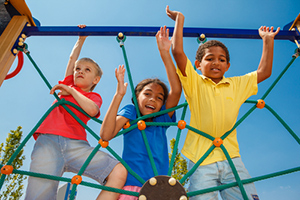
Playground Safety
Everything you need to know to keep your kids safe at the playgroundWith active supervision and some basic safety tips, every day at the playground can be a walk in the park.
Supervise Kids Using Playground Equipment
Actively supervise children on playgrounds. It wont be hard, they'll probably be calling for you to watch them climb, jump and swing.Check playground where your children play. Look for age-appropriate equipment and hazards, such as rusted or broken equipment and dangerous surfaces. Report any hazards to the school or appropriate local office.
Teach children that pushing, shoving or crowding while on the playground can be dangerous.
Dress appropriately for the playground. Remove necklaces, purses, scarves or clothing with drawstrings that can get caught on equipment and pose a strangulation hazard. Even helmets can be dangerous on a playground, so save those for bikes.
Little kids can play differently than big kids. It is important to have a separate play area for children under 5.
Falls are the most common type of playground injury, accounting for more than 75 percent of all playground-related injuries. Lack of or improper supervision is associated with approximately 45 percent of playground-related injuries.
Choose the Right Play Area Based on Your Child's Age
Ensure that children use age-appropriate playground equipment. Separate play areas for bigger kids and children under 5 should be available and maintained.For babies who are mostly crawling or at best learning to walk, the play area should have a smooth and easy surface to walk on.
If your baby has fairly good head control and can sit up with support (usually around 9 months old), give the baby (bucket-shaped) swings a try.
Ensure Safe Surfacing Beneath and Surrounding Playground Equipment
Avoid playgrounds with non-impact absorbing surfaces, such as asphalt, concrete, grass, dirt or gravel.
Recommended surface materials include: sand, pea gravel, wood chips, mulch and shredded rubber. Rubber mats synthetic turf and other artificial materials are also safe surfaces and require less maintenance.
Surfacing should be at least 12 inches deep and extend at least 6 feet in all directions around stationary equipment, surfacing may need to extend farther than 6 feet.
For swings, make sure that the surfacing extends, in the back and front, twice the height of the suspending bar. So if the top of the swing set is 10 feet high, the surfacing should extend 20 feet.
Check That Playground Are Inspected and Maintained by Qualified Personnel
Double check with your school and child care center to make sure they have age-appropriate, well- maintained playground equipment.
If there are any hazards in a public or backyard playground, report them immediately and do not allow children to use the equipment until it is safe.
Report any playground safety hazards to the organization responsible for the site (e.g., school, park authority or city council).
For more information visit safekids.org
